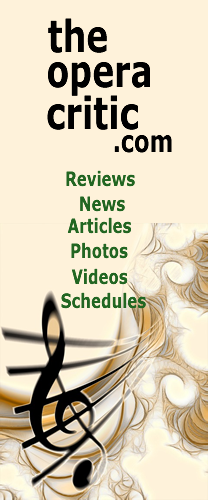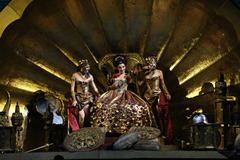| Opera Reviews | 27 July 2024 |
Orlando Furioso proves to be the highlight of this year's festivalby Silvia Luraghi |
|
| Vivaldi: Orlando Furioso Festival della Valle d'Itria, Martina Franca 31 July 2017 |
|
|
The opera is Vivaldi's third attempt at bringing to the stage Ludovico Ariosto's homonymous poem. In order to give a common thread to the paladin's deeds, Vivaldi chose the island of the sorceress Alcina as the setting for the whole action. Vocally, the score features a mixture of voices with similar range, including a contralto (Orlando), a mezzo (Bradamante), and two countertenors (Medoro and Ruggiero), accompanied by two sopranos (Alcina and Angelica) and a bass (Astolfo). In this way, the four warriors, including the female Christian warrior Bradamante, the paladin Orlando, and the two saracens Ruggiero and Medoro, are characterized by similar tessituras. This vocal setting demands a quartet of differently colored and agile voices that can master the arias and convey the meaning of the recitativi in a compelling way. In Martina Franca this was happily the case. Orlando was contralto Sonia Prina, an experienced baroque specialist, whose richly colored voice and heroic style fit perfectly the complex character of Orlando. Countertenor Luigi Schifano was recruited at the last moment for the role of Ruggiero, and proved to be well cast. His creamy voice, which flows perfectly naturally, sounded seductive from his first appearance and his aria “Sol da te mio dolce amore” was one of the highlights of the performance. As Medoro, countertenor Konstantin Derri also displayed a handsome and well tuned voice, while mezzo Loriana Castellano was a fascinating Bradamante, feminine in spite of her male attire. Soprano Michela Antenucci lent Angelica her light, ringing voice. Soprano Lucia Cirillo mastered the role of Alcina with a skillful technique, and so did bass Ricardo Novaro as Astolfo. The production directed by Fabio Ceresa relied on the collaboration of set designer Massimo Checchetto, costume designer Giuseppe Palella, and light designer Giuseppe Calabrò, who all gave outstanding contributions. The full moon dominating the background turns forward and becomes a large shell, the setting of Alcina´s enchanted realm. Seduction is on the foreground, and Alcina's island is somewhat remindful of a Wagnerian Venusberg. But the moon appears again in the background, when Astolfo reaches the island with the hippogriff. The ensemble I barocchisti conducted by Diego Fasolis sounded perfectly at home in Vivaldi´s score. The only reason for criticism by the best informed members of the audience was the breadth of the cuts that the stage director had asked to make in the score, leaving out a sizeable part of the recitativi and even parts of some arias. The performance enjoyed a great success, not only at the end but after many of the arias, which were cheered with enthusiastic and unanimous applause by the audience.
|
|
| Text ©
Silvia Luraghi Photo © Festival della Valle D'Itria |

 A gorgeous production of Antonio Vivaldi's Orlando Furioso was this year's highlight of the Festival della Valle d'Itria in Martina Franca. The enterprise is the result of a co-production with Venice's Teatro La Fenice, where however spectators will see a likely very different staging, as the work will be shown at the much smaller Teatro Malibran: a pity, because the large open space provided by the Palazzo Ducale in Martina Franca was an important part of the setting.
A gorgeous production of Antonio Vivaldi's Orlando Furioso was this year's highlight of the Festival della Valle d'Itria in Martina Franca. The enterprise is the result of a co-production with Venice's Teatro La Fenice, where however spectators will see a likely very different staging, as the work will be shown at the much smaller Teatro Malibran: a pity, because the large open space provided by the Palazzo Ducale in Martina Franca was an important part of the setting.





